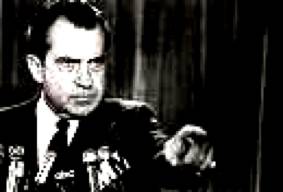by Yale Richmond
The writer continues his occasional series of vignettes from a long career dealing with Russia and her neighbors. –Ed.
Much has been made of Richard M. Nixon’s 1972 visit to China, a visit that ended 20 years of a frosty relationship, opened a new era in U.S.-China relations, and even produced an opera based on the visit. But few today recall Nixon’s 1959 visit to Warsaw and the impact it had, not only in Poland but in other East European countries that were then rightly called Soviet satellites.
Nixon arrived in Warsaw on August 2 for a stopover on his way home from a successful ten-day visit to the Soviet Union where he had opened a huge U.S. national exhibition and had lengthy and frank talks with Soviet premier Nikita Khrushchev on U.S.-Soviet differences. But although Poland’s government was also communist, the country was very different from the Soviet Union. Poland’s people were Roman Catholic; they disliked the Russians, and were solidly opposed to communism. Moreover, the country had cultural links with the West going back more than a thousand years, as well as historic ties with the United States. A revolution in 1956 had replaced a Stalinist government with one of national communism which permitted private agriculture, ceased overt harassment of the Catholic Church, and restored academic freedom. Although still a member of the Soviet-led Warsaw Pact and subservient to Moscow in many respects, the new Polish government sought closer relations with the West, and with the United States in particular.

Fearing a public manifestation of friendship for America, the Polish government was apprehensive about the Nixon visit, and to control the anticipated crowds and provide additional security; his plane was scheduled to arrive, not at Warsaw’s main airport, but at a military field outside the city. Moreover, Nixon’s route into the city was not announced, and the roads were not festooned with flags, as was customary for high-level visitors from abroad. But the route had been announced by Polish-language broadcasts of Radio Free Europe and, as a result, more than 100,000 Poles turned out on their own initiative to greet the U.S. Vice President, the first high-level Western official to visit communist Eastern Europe.
At the airport, the arrival ceremonies were correct but subdued; Nixon was given appropriate honors, including greetings by Polish government officials and review of an elite military honor guard. Welcoming Nixon was Oscar Lange who, as Vice Chairman of the Polish Council of State, had a rank equivalent to the U. S. Vice President. The Polish-born Lange, a noted economist, had been a professor at the University of Chicago from 1938 to1946, and resumed his Polish citizenship when he served as Poland’s ambassador to Washington, 1946 to early 1947 when he was replaced after the communist government had eliminated all opposition.
Seated in an open Soviet-made limousine, Nixon and Lange led a modest cortege into the city, and that’s when the demonstration began. Polish spectators began blowing kisses and throwing bouquets of flowers at Nixon’s car, not government-issued flowers but ones they had purchased, and Nixon’s car had to be stopped several times to remove flowers from the hood so the driver could see where he was going. As the convoy entered the inner city, the crowds grew, and so did the flowers, thrown not only at Nixon but at other Americans following in their cars. I was driving my own Ford sedan a few cars behind the vice president, and I too had to stop to remove flowers that were piling up in front of my windshield. After his Moscow visit Nixon was tired and despondent, and he felt he had not done well there, but the spontaneous Polish welcome buoyed him and restored his confidence.
The next day, Nixon met with Wladyslaw Gomulka, the communist leader of Poland, for five hours and twenty minutes of hard give-and-take on U.S.-Polish relations. As in Moscow, the two leaders engaged in a discussion that avoided the propaganda slogans of the Cold War and opened a new era of summit diplomacy in which the two sides could frankly and openly discuss East-West differences.
Another expression of Polish warmth toward the United States surfaced when Nixon placed a wreath on the tomb of Poland’s unknown soldier. After the ceremony, the crowd rushed forward and tried to embrace Nixon. One Pole fell to his knees and wrapped his arms around Nixon. A father thrust his child into the vice president’s arms, a move which every politician welcomes and knows how to handle.
Before departing Poland, Nixon visited the Warsaw cathedral of Poland’s Roman Catholic Primate, Stefan Cardinal Wyszynski. It was meant to be a symbolic gesture acknowledging the faith that had sustained Poland throughout the centuries, but it was done without upsetting the fragile truce between the Church and Poland’s communist regime that had begun only three years earlier. In recognition of the delicacy of the situation, the Cardinal was said to be on vacation at the time but he sent a personal note to the Vice President.
As then U.S. ambassador to Poland Jacob D. Beam has described the Nixon visit, “…the demonstration celebrating Nixon’s arrival scared the living daylights out of the Polish communist leaders…it taught them that they could not rely on the Polish people under all conditions….”*
Jacob D. Beam, Multiple Exposure; An American Ambassador’s Unique Perspective on East-West Issues (New York: W.W. Norton and Co., 1978).

Yale Richmond is a writer and former Foreign Service Officer who lives in Washington, D.C. His latest books are Understanding the Americans: A Handbook for Visitors to the United States (Hippocrene Books, 2009), and From Nyet to Da: Understanding the New Russia, 4th edition (Intercultural Press, 2009).
